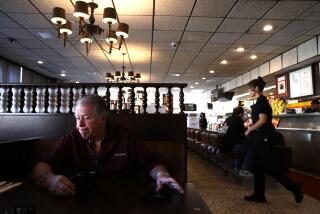500-foot move for historic home ignites battle : Rotting Alexander Hamilton Grange would be restored in park, but N.Y. neighbors are furious.
- Share via
NEW YORK — The National Park Service plan to restore the 192-year-old home once inhabited by Alexander Hamilton--known as the Hamilton Grange--seemed so practical to many of its backers that they still cannot believe the controversy the proposal has generated.
Since 1992, Hamilton’s two-story, Federal-style house has been closed to the public because of structural rot, its 70,000 annual visitors an increasingly dim memory. The Park Service proposal: move the Grange from its cramped quarters in the Hamilton Heights section of West Harlem to St. Nicholas Park, 500 feet from where it now rests, in order to allow for the best possible renovation.
But what no one had counted on was a fierce two-year battle that pitted community residents against one another as the question was debated: Is it better to commemorate in a proper style Hamilton’s place in U.S. history or preserve the history of a contemporary American neighborhood?
“I was really sort of shocked, not at the opposition but at the amount of opposition and the really horrifically nasty and bitter dimensions that it took on,” said area resident Michael Henry Adams, president of the Upper Manhattan Society for Progress Through Preservation.
The Park Service, with the support of Rep. Charles B. Rangel (D-N.Y.), hopes to spend an estimated $11 million to restore Hamilton’s summer home. A Revolutionary War patriot, the first secretary of the Treasury and creator of the nation’s monetary system, Hamilton died in an 1804 duel with then-Vice President Aaron Burr.
Yet the proposal to move the Grange and restore as many of its original features as possible encountered strong opposition from a neighborhood that views itself as increasingly threatened by crime, drugs and neglect.
Even a promise to build a new community center on the current site of the Grange changed few minds. “To take away this building would destabilize the neighborhood,” said Bernice Cummings-Ubiles, a member of the Community Task Force to Prevent Removal of the Grange. “In New York City, buildings go up next to each other, they grow with the area, they mark the passing of time. In 1802, this area was suburban and it’s no longer that. . . . We live in an urban area, and to move this building to a rustic setting makes no sense.”
Built in 1802, the Grange served as the centerpiece of a 32-acre summer estate designed by noted architect John McComb Jr., who also created New York City Hall. It survived intact until 1889 when, threatened with destruction as a result of the development of Hamilton Heights, it was moved 350 feet from its original location to a site adjacent to St. Luke’s Episcopal Church.
In the process the house lost many original features. The new front entrance originally served the Hamilton family as a side portal. Porches were destroyed and the interior of the house altered. In 1910, an apartment building was built on its north side, further encroaching on the structure.
“It’s squeezed, and I mean tightly squeezed, between these two buildings,” said Park Service spokesman Steve Laise.
Opponents of the Park Service plan say the home can be restored to much of its original grandeur at its current location.
Many neighborhood activists are concerned about the agency’s somewhat sketchy record with regard to historic sites, such as its caretaking of the Grange and nearby Grant’s Tomb. The final resting place of America’s 18th President is frequently vandalized and marked with graffiti, and even the Park Service admits that homeless people sleep inside the structure almost every night.
As a result, many area residents doubt that the promised community center will be built on the site of the Grange, leaving them with a vacant lot. In addition, they question the wisdom of moving the Grange to an infrequently tended and often garbage-strewn area of New York City-owned St. Nicholas Park. Park Service assurances that the site will be guarded 24 hours a day receive a cynical reception.
“You have a community that doesn’t believe in promises and realizes they will have to stay on the case till the last nail is banged in,” said Ted Kovaleff, the chairman of Community Board 9, the area’s governing body. “We’re living in a time of budgetary stringency and cutbacks in state, city and federal budgets. Everyone out there is looking for a place to cut, and unfortunately our community is viewed as ripe for it.”
Momentum seems to be with the National Park Service plan. After several months of postponed votes, Community Board 9 decided in March to throw its support behind moving the Grange. The Park Service hopes to begin construction sometime in 1995.
But opponents aren’t throwing in the towel just yet. One possible plan of attack: fighting the appropriation of public space in St. Nicholas Park, which also has a claim on history. The park was designed at the turn of the century by noted architect Samuel Parsons Jr.
More to Read
The biggest entertainment stories
Get our big stories about Hollywood, film, television, music, arts, culture and more right in your inbox as soon as they publish.
You may occasionally receive promotional content from the Los Angeles Times.










